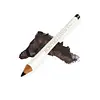What's inside
What's inside
 Key Ingredients
Key Ingredients

 Benefits
Benefits

 Concerns
Concerns

 Ingredients Side-by-side
Ingredients Side-by-side

Water
Skin ConditioningStyrene/Acrylates/Ammonium Methacrylate Copolymer
Butylene Glycol
HumectantCalcium Sodium Borosilicate
Silica
AbrasiveLaureth-2 Benzoate
EmollientSorbitol
HumectantSodium Cocoyl Apple Amino Acids
Skin ConditioningCaprylyl Glycol
EmollientCoconut Acid
CleansingSodium Chloride
MaskingTocopherol
AntioxidantCI 77491
Cosmetic ColorantCI 77492
Cosmetic ColorantCI 77499
Cosmetic ColorantMica
Cosmetic ColorantUltramarines
Titanium Dioxide
Cosmetic ColorantCI 77891
Cosmetic ColorantWater, Styrene/Acrylates/Ammonium Methacrylate Copolymer, Butylene Glycol, Calcium Sodium Borosilicate, Silica, Laureth-2 Benzoate, Sorbitol, Sodium Cocoyl Apple Amino Acids, Caprylyl Glycol, Coconut Acid, Sodium Chloride, Tocopherol, CI 77491, CI 77492, CI 77499, Mica, Ultramarines, Titanium Dioxide, CI 77891
Water
Skin ConditioningAlcohol Denat.
AntimicrobialStyrene/Acrylates/Ammonium Methacrylate Copolymer
Propanediol
SolventButylene Glycol
HumectantSodium Polymethacrylate
Emulsion StabilisingSilica
AbrasiveSorbitol
HumectantC12-15 Alkyl Benzoate
AntimicrobialEthylhexyl Palmitate
EmollientEthylhexylglycerin
Skin ConditioningCeramide NP
Skin ConditioningSodium Laureth-12 Sulfate
CleansingXanthan Gum
EmulsifyingPanthenol
Skin ConditioningAmmonium Hydroxide
BufferingSilica Dimethyl Silylate
EmollientPolymethyl Methacrylate
Caprylyl Glycol
EmollientHexylene Glycol
EmulsifyingSodium Hyaluronate
HumectantTocopherol
AntioxidantPhenoxyethanol
PreservativeCI 77499
Cosmetic ColorantWater, Alcohol Denat., Styrene/Acrylates/Ammonium Methacrylate Copolymer, Propanediol, Butylene Glycol, Sodium Polymethacrylate, Silica, Sorbitol, C12-15 Alkyl Benzoate, Ethylhexyl Palmitate, Ethylhexylglycerin, Ceramide NP, Sodium Laureth-12 Sulfate, Xanthan Gum, Panthenol, Ammonium Hydroxide, Silica Dimethyl Silylate, Polymethyl Methacrylate, Caprylyl Glycol, Hexylene Glycol, Sodium Hyaluronate, Tocopherol, Phenoxyethanol, CI 77499
Ingredients Explained
These ingredients are found in both products.
Ingredients higher up in an ingredient list are typically present in a larger amount.
Butylene Glycol (or BG) is used within cosmetic products for a few different reasons:
Overall, Butylene Glycol is a safe and well-rounded ingredient that works well with other ingredients.
Though this ingredient works well with most skin types, some people with sensitive skin may experience a reaction such as allergic rashes, closed comedones, or itchiness.
Learn more about Butylene GlycolCaprylyl Glycol is a humectant and emollient, meaning it attracts and preserves moisture.
It is a common ingredient in many products, especially those designed to hydrate skin. The primary benefits are retaining moisture, skin softening, and promoting a healthy skin barrier.
Though Caprylyl Glycol is an alcohol derived from fatty acids, it is not the kind that can dry out skin.
This ingredient is also used as a preservative to extend the life of products. It has slight antimicrobial properties.
Learn more about Caprylyl GlycolCi 77499 is also hydrated iron III oxide. It is created from mixing red and black iron oxides. This helps give shades of darkness to a product.
Iron III oxides are classified as inorganic chemicals for coloring.
Silica, also known as silicon dioxide, is a naturally occurring mineral. It is used as a fine, spherical, and porous powder in cosmetics.
Though it has exfoliant properties, the function of silica varies depending on the product.
The unique structure of silica enhances the spreadability and adds smoothness, making it a great texture enhancer.
It is also used as an active carrier, emulsifier, and mattifier due to its ability to absorb excess oil.
In some products, tiny microneedles called spicules are made from silica or hydrolyzed sponge. When you rub them in, they lightly polish away dead skin layers and enhance the penetration of active ingredients.
Learn more about SilicaSorbitol is a sugar alcohol. It is a hydrating and moisturizing agent created from the reduction process of glucose.
Most sorbitol is usually made from potato starch. It is also found in fruits such as apples and pears.
As a humectant, Sorbitol helps draw water to the skin. This helps keep the skin hydrated. Sorbitol also helps create a thicker texture in products. You might find sorbitol in your toothpaste and other gels.
It is a non-irritating ingredient that is great for those with dry skin.
Sorbitol is a prebiotic. It helps promote the growth of healthy bacteria on your skin. The bacteria on your skin form a microbiome. This microbiome helps protect your skin from infection and harmful bacteria.
Learn more about SorbitolWe don't have a description for Styrene/Acrylates/Ammonium Methacrylate Copolymer yet.
Tocopherol (also known as Vitamin E) is a common antioxidant used to help protect the skin from free-radicals and strengthen the skin barrier. It's also fat soluble - this means our skin is great at absorbing it.
Vitamin E also helps keep your natural skin lipids healthy. Your lipid skin barrier naturally consists of lipids, ceramides, and fatty acids. Vitamin E offers extra protection for your skin’s lipid barrier, keeping your skin healthy and nourished.
Another benefit is a bit of UV protection. Vitamin E helps reduce the damage caused by UVB rays. (It should not replace your sunscreen). Combining it with Vitamin C can decrease sunburned cells and hyperpigmentation after UV exposure.
You might have noticed Vitamin E + C often paired together. This is because it is great at stabilizing Vitamin C. Using the two together helps increase the effectiveness of both ingredients.
There are often claims that Vitamin E can reduce/prevent scarring, but these claims haven't been confirmed by scientific research.
Learn more about TocopherolWater. It's the most common cosmetic ingredient of all. You'll usually see it at the top of ingredient lists, meaning that it makes up the largest part of the product.
So why is it so popular? Water most often acts as a solvent - this means that it helps dissolve other ingredients into the formulation.
You'll also recognize water as that liquid we all need to stay alive. If you see this, drink a glass of water. Stay hydrated!
Learn more about Water